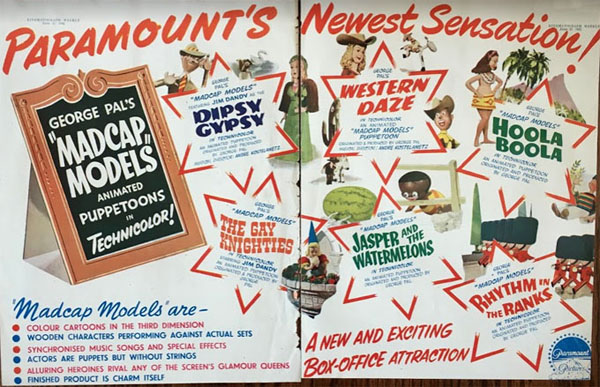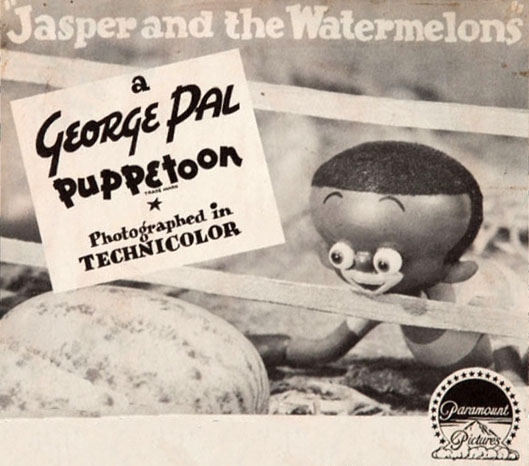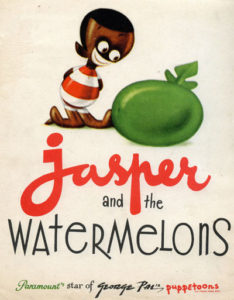
In its March 9th, 1942 issue, Time magazine did something it had rarely done before—reporting about an animated short subject. The periodical called the film Jasper and the Watermelons “a new departure in the field of U.S. animated cartooning” because of producer/director George Pal’s use of puppets instead of drawings. However, the episode was not the first of Pal’s “Puppetoons,” which Paramount Pictures had been distributing to theaters since January 1941.
Jasper and the Watermelons was merely the first “Puppetoon” starring Jasper—a fictional African American boy. Jasper was part of a tradition in US animation of casting African American boys as stars of series—from “Sammy Johnsin” in the Silent Era to Bosko of Metro-Goldwyn-Mayer’s “Happy Harmonies” and L’il EIghtball from producer Walter Lantz.
These boys were examples of the “Sambo” characterization. This figure was juvenile in behavior if not in age, gullible, and harmless. The “Sambo” was ascribed by supporters of segregation to African American men as a means of discouraging the extension of equal rights to them. They were portrayed as too immature to exercise citizenship. At this time, the children’s book The Story of Little Black Sambo was a staple in elementary schools and public libraries. Pal had numerous sources in American culture from which to draw in order to adapt “Sambo” to puppetry.

What separates the “Jasper” series of its debut year (1942) from most of the animated films with African American caricatures is the effort put forth by Pal to include African Americans in the aural part of the film. Child actor Glenn Leedy provided Jasper’s voice, and actor Roy Glenn played the role of Scarecrow. Both Jasper’s debut Jasper and the Watermelons and his other 1942 cartoon Jasper and the Haunted House (see below) feature music by an African American choral group from Los Angeles known as the Carlyle Scott Chorus. Moreover, the music strongly features the singers’ vocals as part of the film’s background; in other words, the singers do not always voice specific on-screen characters but rather serve to reinforce the settings and the plots.
 Pal relies heavily on longtime tropes of African American caricature. Both films are set in a rural environment—likely the South because of songs like “Short’nin’ Bread” in the music score. Jasper and his mother live in a run-down wooden house resembling African American plantation quarters. Jasper calls his mother “mammy.” All the characters—Jasper, Mammy, Scarecrow, and Crow—speak in minstrel dialect. The debut film refers to the stereotype of African American fondness for watermelon, and the second film is merely a puppet-version of the many preceding live-action and animated films featuring African Americans bugging their big eyes at the sight of ghosts. I’ve already written on two such films for this website—Hittin’ the Trail to Hallelujahland and A Haunting We Will Go.
Pal relies heavily on longtime tropes of African American caricature. Both films are set in a rural environment—likely the South because of songs like “Short’nin’ Bread” in the music score. Jasper and his mother live in a run-down wooden house resembling African American plantation quarters. Jasper calls his mother “mammy.” All the characters—Jasper, Mammy, Scarecrow, and Crow—speak in minstrel dialect. The debut film refers to the stereotype of African American fondness for watermelon, and the second film is merely a puppet-version of the many preceding live-action and animated films featuring African Americans bugging their big eyes at the sight of ghosts. I’ve already written on two such films for this website—Hittin’ the Trail to Hallelujahland and A Haunting We Will Go.
The films are predictable in terms of plot. Scarecrow and Blackbird convince Jasper to go along with one of their schemes, and either Jasper or all three suffer as a result. Then Jasper beats up Scarecrow and Blackbird for getting him into each mess. The formula is similar to that of the African American characters in the series Amos ‘n’ Andy on radio at the time, in which Andy falls for the Kingfish’s schemes. In Jasper’s debut he is convinced to disobey his mother and eat from the watermelon patch. In the second film, Jasper is misdirected by Scarecrow to a haunted house when delivering a gooseberry pie.
The settings are impressive and imaginative, as is the animation—especially of the watermelon-juice rain in the debut. The pacing of gags is often slow, and Pal’s heavy reliance on dialogue minimizes the animation in the cartoons. The verbal interplay between Scarecrow and Crow is occasionally humorous. The singing of the Carlyle Scott Chorus is first-rate.
I argued in The Colored Cartoon that technical achievements in animation went hand-in-hand with African American tropes. There’s the minstrel soundtrack in Walt Disney’s pioneering sound cartoon Steamboat Willie, the rotoscoping of Cab Calloway in Max Fleischer’s cartoons, the beautiful technicolor and fluid animation of Metro-Goldwyn-Mayer’s “Happy Harmonies,” and later the live-action/animated combination in Disney’s Song of the South and minstrel caricatures in the first CinemaScope cartoon—Disney’s Toot, Whistle, Plunk and Boom. What Time magazine did in 1942 was herald the marriage of the tropes to puppetry.


 Christopher P. Lehman is a professor of ethnic studies at St. Cloud State University in St. Cloud, Minnesota. His books include American Animated Cartoons of the Vietnam Era and The Colored Cartoon, and he has been a visiting fellow at Harvard University.
Christopher P. Lehman is a professor of ethnic studies at St. Cloud State University in St. Cloud, Minnesota. His books include American Animated Cartoons of the Vietnam Era and The Colored Cartoon, and he has been a visiting fellow at Harvard University.



























I did the most heavy rewrites of the WIkipedia article of “Jasper and the Haunted House” since I discovered the Puppetoon Movie DVD version uploaded to YouTube for the first time long ago after seeing bad UM&M copies. I just erased the whole article and over time did a good job describing every nook and cranny of the plot.
BTW, what’s that boogie-woogie swing piece played at the climax of the Haunted House episode?Was it an original piece?
I hope you’re going to talk about “Hoola Boola” at some point: No Jasper, but unforgettable visuals tied to played-out old cannibal gags.
Maybe we’ll have one on “John Henry & The Inky-Poo” someday too.
HOOLA BOOLA (1941) partially remakes the earlier SOUTH SEA SWEETHEARTS (1938), one of his British (Horlick’s) backed Netherlands shorts. However the earlier film is less offensive in my opinion because it is intended to be more of a parody of cannibal adventures. One of the “natives” even talks like a Ted Husing-like sports announcer during a fight scene. Obviously the ’41 film is much more elaborate in production values but also plays up the “spook” jokes.
“Obviously the ’41 film is much more elaborate in production values but also plays up the ‘spook’ jokes.”
Wait, the “S-word” is OK??
I had to look that one up. Surprisingly I hadn’t heard that word being also used as a derogatory term. The film in question doesn’t use it in that way, since the gag involves jungle spirits (original definition and the one I was thinking).
As the series went on, I believe that the character of Jasper was voiced by Sarah Berner who also provided the faux-dialect for the little child in the Tex Avery cartoon, “UNCLE TOM’S CABANA”, but the other African-American voices remained for the other characters. Yet, there were other African-American voices that were heard, like the singing harp in “JASPER AND THE BEANSTALK”; I wonder who she was. Perhaps, if, one day (wish wish), the entire PUPPETOONS library is issued on DVD, there could be a mini-documentary on all the African-American talent behind the JASPER series. Despite the blatant stereotyping, the performers did beyond the best they could to bring the stories to life. I look forward to future restorations, just so I can hear the musical performances so much clearer.
The voice of the singing harp was provided by Peggy Lee, who reprised her role in Jasper in a Jam.
Ken, the singing harp is voiced and sung by Peggy Lee as in “Jasper in A Jam”
Arnold Leibovit
The WATERMELON one was available online at one point (maybe not now) and I rather enjoyed it more than THE HAUNTED HOUSE due to all of the dazzling Robert Clampett-ish Wackyland visuals. They really put a lot of production into that one.
Of course, George Pal already tapped into the watermelon “joke” earlier in a 1937 Netherlands produced puppetoon, DE GROOTE PHILIPS REVUE 1938 (featured with its English title in both the older and newer DVDs of THE PUPPETOON MOVIE). Now… that is a weird one. While the newer film makes better use of it in its farm setting (just like Farina liking his melons in the earlier “Our Gang” comedies that were often set in semi-rural country), the older film had them featured (and misspelled on sign) on a city street full of urban jazz music. Go figure.
Arnold Lebovit is the one responsible for removing a lot of the obscure Puppetoons, just because he owns the trademark. Viacom should be the real remover of these youtube.links since they own the copyrights through Paramount/Melange.
Lebovit met Pal, knows his family, protects his family, so he goes overboard about streaming Puppetoons.
Luckily, Archive.org, back when they still uploaded public domain material, uploaded the Puppetoon Movie DVD version of the Haunted House adventure because I asked so. So that’s why you see multiple uploads on YT of the Haunted House adventure because the cartoon itself fell into the public domain.
I agree with all your remarks about the racist tropes in “Jasper and the Watermelons”.
But you fail to point out that it’s an amazing film! All the work in the short – the design, the animation, the lighting, the editing – is absolutely incredble. I think it’s just about the best Puppetoon Pal ever made, and one of the greatest stop motion shorts ever made by anyone, right up there with Starewicz’ “The Mascot”.
While we should note and discuss the systemic racism in films of the time, that shouldn’t prevent us from also recognizing great artistic achievement when we see it.